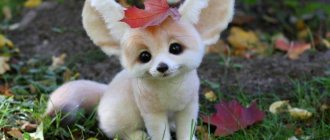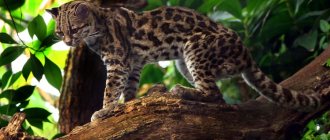21 species of big wild cats in 41 special photographs. We all know about lions, tigers, pumas, leopards and even jaguars, but there is a whole world of wild cats beyond our knowledge - a special group of rare, small or even mysterious species that you have probably never heard of! The list of wild cats familiar to us is far from complete, but the thirst for knowledge is bursting to see what other soft-footed, furry individuals exist. Depending on their habitat, cats in the wild vary in color, length of legs, tail and neck, but each feline is naturally charming in its own way. Apart from lions, all other species of large and small cats hunt alone. This is not surprising, just watch our pets - they are such arrogant individualists.
© Copyright for the presented photographs belongs to their authors.
Canadian lynx. Canadian Lynx (Lynx Canadensis)
The Canadian lynx is a species of lynx that lives in the North American taiga. The closest relative of the common lynx.
Felidae evolved into a separate family approximately 25 million years ago. Since then, they have expanded their habitats around the world and adapted to suit their environment. Cats not only prefer meat, they are all carnivores and cannot exist without it, although there are also spoiled pets who can feast on sweets from your table. According to researchers, the cat family is divided into 37 species based on molecular data. Get to know all the species, or almost all of them, because many animals are still simply unknown to science, rare cats on one page, and not scouring the entire Internet!
It’s strange why the lynx is considered a rare species of wild cat?
What does a forest cat eat?
Photo: Wild forest cat
Cats obtain food by hunting smaller animals. The diet of forest predators largely depends on the season.
In good weather, the main prey of a feline hunter is considered to be:
- small animals (mice, squirrels, chipmunks, weasels, minks, etc.);
- amphibians and reptiles (frogs, snakes, lizards);
- fish (small representatives swimming mainly near the surface of the water);
- birds (and especially chicks or eggs left by winged parents in the nest).
Hunting cats give preference to those birds that live and nest on the ground.
Interesting fact: Particularly insightful and fearless representatives of wild cats are capable of killing a hare, roe deer or even a deer! True, this only happens when a large animal is already weakened and is not able to move quickly, or defend itself from cat attacks.
In winter, things are much worse with food. Due to heavy snow and frost, the number of birds is reduced, many animals prefer to hibernate or simply sit out in warm shelters, and fish hide under the crust of ice that covers the river. Hunting is very difficult. Cats have to track and wait for their prey for a long time. It is precisely because of the difficult hunting conditions in winter that the animals gain most of their weight in the summer. The accumulated fat allows them not to freeze and maintains the normal functioning of organs.
Interesting fact: Only in winter can felines approach human settlements. Here they brazenly steal chickens and other small livestock.
Wild cats hunt only at night. The best time to capture prey is sunset and dawn (between these events the animal sleeps in its shelter). Moreover, if it rains at night, the cat refuses to be hot.
Sand or dune cat. Sand Cat (Felis Margarita)
The sand cat is distinguished by the smallest size among wild cats: its body length is 65-90 cm, with 40% occupied by the tail, height at the withers is 24-30 cm; the weight of adult males is 2.1-3.4 kg, females are smaller. The head is large and wide, flattened, with sideburns. The ears are very large and wide, without tufts.
The range of the dune cat looks like a strip starting in the Sahara (Algeria, Morocco, Chad, Niger) and through the Arabian Peninsula running into Central Asia (Turkmenistan, Uzbekistan, Kazakhstan) to the outskirts of Nushka in Pakistan.
Social structure and reproduction
Photo: Far Eastern forest cat
Unlike domestic cats, forest cats mate only once a year and mainly between January and March. The female and male unite in a union only for the time of conception of offspring. Cats lure cats with a characteristic smell that spreads after the territory has been marked. The males responding to the scent begin a fierce fight among themselves.
The female allows only the strongest to approach her. The mating process takes place in a hollow tree (at a short distance from the ground) or in a hole abandoned by another animal. In this case, the mating site is arranged in advance for the young offspring. The “floor” is covered with leaves, grass and even bird feathers. After the kittens are conceived, the parents separate again. The expectant mother is left alone and awaits the birth of her offspring, taking care of them in advance. She arranges the home in the best possible way for childbirth.
Pregnancy of wild cats lasts for 2-4 months. At one time, a female is capable of giving birth to from 1 to 7 kittens. All cubs are born blind (sight comes only on the 9-12th day after birth) and helpless. They weigh only 250 grams and practically do not stand on their paws. They cannot do without maternal help in the first weeks of their life. The mother takes care of her cubs with love and reverence. It provides them with food and security. Only at one month do kittens begin to actively crawl. And already at 2, they go on their first hunt with their mother. Kittens that are more than 2 months old are very voracious. They are able to pet up to 7 mice a day, supplementing their diet with mother's milk.
Baby cats are very playful and inquisitive. They quickly move around their parent territory and move through the trees without fear. At the age of 5 months they set off into adulthood. The cats leave their mother's land and begin searching for their hunting territory. Cats remain within the mother’s area, but set up their own den. Sexual maturity of animals occurs at the age of 10 months.
Manul. Pallas Cat (Otocolobus Manul)
It received its second name - Pallas's cat - in honor of the German naturalist Peter Pallas, who first described the Pallas cat in the 18th century. The synonymous Latin name Otocolobus comes from the Greek us, otos - ear, kolobos - ugly, that is, “ugly ear”.
Pallas's cat is distributed in Central and Central Asia, from Southern Transcaucasia and western Iran to Transbaikalia, Mongolia and Northwestern China.
Black-footed cat. Black-footed Cat (Felis Nigripes)
One of the smallest modern representatives of the cat family. Average weight - 1.6 kg, body length 36-52 cm, tail - 13-20 cm.
The black-footed cat is found in the desert areas of southern Africa. Color – sandy yellow with dark spots. Black-footed cats occupy rabbit or termite burrows.
Caracal or steppe lynx. Caracal (Caracal Caracal)
For a long time, the caracal was classified as a lynx, which it resembles in appearance, but a number of genetic features distinguished it into a separate genus. Despite this, the caracal is still a little closer to lynxes than other cats, while being much closer to the puma in morphological characteristics.
The caracal is also close to the African serval, with which it interbreeds well in captivity. It is found in savannas, deserted steppes, deserts and foothills of Africa, in the deserts of the Arabian Peninsula, Asia Minor and Central Asia, and the Middle East. It is rare in the CIS: it is found in the deserts of Southern Turkmenistan, along the coast of the Caspian Sea it reaches the Mangyshlak Peninsula, in the east it sometimes appears in Kyrgyzstan and the Bukhara region of Uzbekistan.
In Russia, single individuals of caracal can be found in the foothills and deserts of Dagestan, but its total number does not exceed 100 individuals.
Features of character and lifestyle
Photo: Amur forest cat
Forest cats are freedom-loving animals that prefer to live alone and do not tolerate competitors on their territory. They have a wary character and often show aggression towards other animals or approaching people (which can be noticed even when visiting a zoo).
Hissing at a person is typical even for those forest cats that they tried to tame. Animals cannot be trained, do not recognize people as heads of the house and, in principle, avoid all neighbors. You cannot have such a pet in a small apartment. He needs a large area - at least a dacha yard. It is worth considering that the animal loves to climb trees and inspect its possessions. There is no need to limit it in this regard.
However, it is likely that at the first opportunity the “domestic” pet will run away from its owners, preferring a wild lifestyle. Forest cats make sounds only during the mating season. In steely times they are very silent. Only occasionally from their “mouths” can one hear the whistling, hissing and howling that is characteristic only of them. All these sounds are produced by cats when aggression is shown towards them. Animals react very quickly. Perhaps this is due to excellent vision, developed hearing and a special sense of smell.
Clouded leopard. Clouded Leopard (Neofelis Nebulosa)
A member of the cat family, living in Southeast Asia. It vaguely resembles a leopard and is considered a fairly ancient species, as well as a possible ancestor of today's large cats.
The body length of a clouded leopard is 61-100 cm, the tail is 75-92 cm. The weight of males is 16-21 kg, females 11-15 kg. The height at the withers is 50-55 cm. Its size corresponds approximately to the size of a shepherd dog.
The clouded leopard is found in southeast Asia, from southern China to Malacca and from the eastern Himalayas to Vietnam. The subspecies found in Taiwan has become extinct. Its biotope is tropical and subtropical forests located at altitudes up to 2000 meters.
Pampas cat. Pampas Cat (Leopardus Pajeros)
For a long time it was believed that this small predatory animal, whose size only slightly exceeds that of the domestic cat, belongs to another category of the genus of tiger cats - Leopardus colocolo. Despite their small size, grass cats (this is the name of these animals in their homeland) look quite massive. The average weight of Pampas cats is 4-7 kg, body length varies from 50 to 75 cm, a third of the size comes from a thick shaggy tail.
Pampas cat. The range of habitat, as the name of the species suggests, extends along a large zone of South American steppes: in the areas of Argentina, Bolivia, Chile, Ecuador and Peru.
Population and species status
Photo: What a forest cat looks like
The exact number of forest cats in their natural habitat is unknown. This is explained by its constant change.
The animal population is declining for several reasons:
- Burning of forests (which occurs as a result of careless human actions);
- High level of garbage (because of it, smaller animals die, which cats feed on);
- Poaching (many hunters try to get a live wild cat in order to domesticate it).
The decline in the number of animals is also due to floods, as well as global climate changes, for which animals are not always prepared. It is worth noting that in some areas the wild cat population has been completely exterminated. Until 1927, two representatives of the cat class could be found in Belarus: lynxes and forest cats. Today, there are none left in this area. Zoologists consider human activity to be the main reason for the extermination of animals. The human desire to become the owner of a unique breed of cats or to enrich themselves by selling it has led to a sharp reduction in the number of representatives of this group in the natural environment.
Interesting fact: To restore the population of forest cats in Belarus, it was decided to purchase animals in Moldova for their further settlement in the state Polesie Nature Reserve.
If it were not for the illegal actions of people (pollution of nature, arson), the number of animals would be much higher. However, forest cats are not currently under serious threat. The only exception is one of the 22 existing species. We are talking about the Caucasian forest cat (Felis silvestris caucasica), listed in the Red Book in Russia.
Jaguarundi. Jaguarundi (Puma Yagouaroundi)
Externally, the jaguarundi somewhat resembles a representative of the mustelidae or civet family - the jaguarundi has an unusually (for a cat) elongated, flexible body on short strong legs and a long thin tail, which overall gives it a resemblance to a weasel or Madagascar fossa. Body length 55-77 cm, tail 33-60 cm, height at withers about 25-35 cm. Jaguarundi weighs 4.5-9 kg.
The jaguarundi lives in Central and South America: from the coast of Mexico to northwestern Argentina. Small populations are found in southern Texas and Arizona.
Leopard cat. Leopard Cat (Prionailurus Bengalensis)
She is also a Bengal cat, a dwarf cat, or a Far Eastern cat. Bengal cats live in South and East Asia. Their size is similar to that of a domestic cat, and they are found in a variety of color variations throughout their vast range. The appearance within the species of Bengal cats varies greatly. In the Primorsky Territory they look completely different than on the islands of Indonesia. In the south, the base color of their coat is more yellow, like a leopard, while in the north it is predominantly gray-brown.
Where does the forest cat live?
Photo: European forest cat
Wild cats are quite common animals. They live in wooded areas of many continents.
The most favorite habitats of individuals are:
- Europe (mainly its Western and Central parts). You can meet animals in Spain and Italy. The range is limited to the north by England and the Baltic Sea;
- Caucasus. Cats also live on the northeastern border with some regions of the former Soviet Union;
- Asia. A greater concentration of animals is observed on the western peninsula of Asia Minor (or Anatolia).
These habitat regions of forest cats are still relevant today. In this case, they are supplemented by the southwestern regions of Ukraine, as well as Eastern Europe. Each representative of wild cats occupies its own territory for housing. Its area is about 2-3 kilometers (in the mountains this figure can be increased several times). Moreover, during the period of searching for a female, males can go much further than the boundaries of their territory. Animals choose mixed dense forests to live. The maximum height of the habitat is 2-3 kilometers above sea level.
Interesting fact: Wild cats are characterized by a hierarchical order of life. For the fertile area, where a large number of small mammals live, males fight “with their fists.”
Animals lead a predominantly solitary lifestyle. Pairing occurs only during the mating period. They try not to get close to human settlements. Low tree hollows act as shelters for wild cats (woody hollows used for breeding are covered with grass and leaves). Individuals living in the mountains prefer to hide in rock gorges, as well as old burrows of other animals. Moreover, if there is both a badger hole and a hollow at the same time, the cat will choose the first type of shelter.
Now you know where the wild forest cat lives. Let's see what he eats.
Viverrid cat or fishing cat. Fishing Cat (Prionailurus viverrinus)
A wild cat of Southeast Asia, distinguished by its ability to fish and swim well. The species is closely related to the Far Eastern cat and is similar to it, but larger in size.
The civet cat or fishing cat is a rare animal, listed in Appendix II of CITES. In appearance, the fish cat resembles a civet (viverra). The weight of an adult animal is from 11 to 15 kg (males), 6-7 kg (cats), with a body length of 96-119 cm, height at the withers of 38-40 cm. It has a strong build and great strength. The muzzle is short and wide, the bridge of the nose is practically absent. The ears are small, round, set low on the sides of the head, the jaw is round, almost like a pit bull's, the lower one is very strong. The head is round, the neck is short. The legs are short, the tail is also short, thick at the base. Color grayish brown with black.
Who are wild cats
Wild cats belong to the family of mammals, the order of carnivores. Most often, they obtain food by stalking (rarely), stalking and sneaking.
All predatory cats lie in wait for prey by stalking and stalking.
Common features of all wild cats
Their sizes are varied - from 1 kg in weight and 34 cm in height to 300 kg and almost 4 m in length. Animals have tiny pointed papillae on their tongues, which make it easier to clean the fur and scrape meat from the bones of prey. Almost all wild cats have long tails and retractable claws. They have 20–30 teeth, which is less compared to other animals. The color of representatives of predatory cats ranges from gray to brownish-red with the following pattern:
- stripes;
- sockets;
- speckled;
- spots
Cat predators are nocturnal or crepuscular, but some populations can hunt during the day. Small cat species give birth to 4–6 cubs, and large cat species give birth to 2–4 cubs. Kittens are born helpless and blind, they are nursed by the mother, and the father rarely takes care of the offspring. Predatory purrs live up to 30 years.











